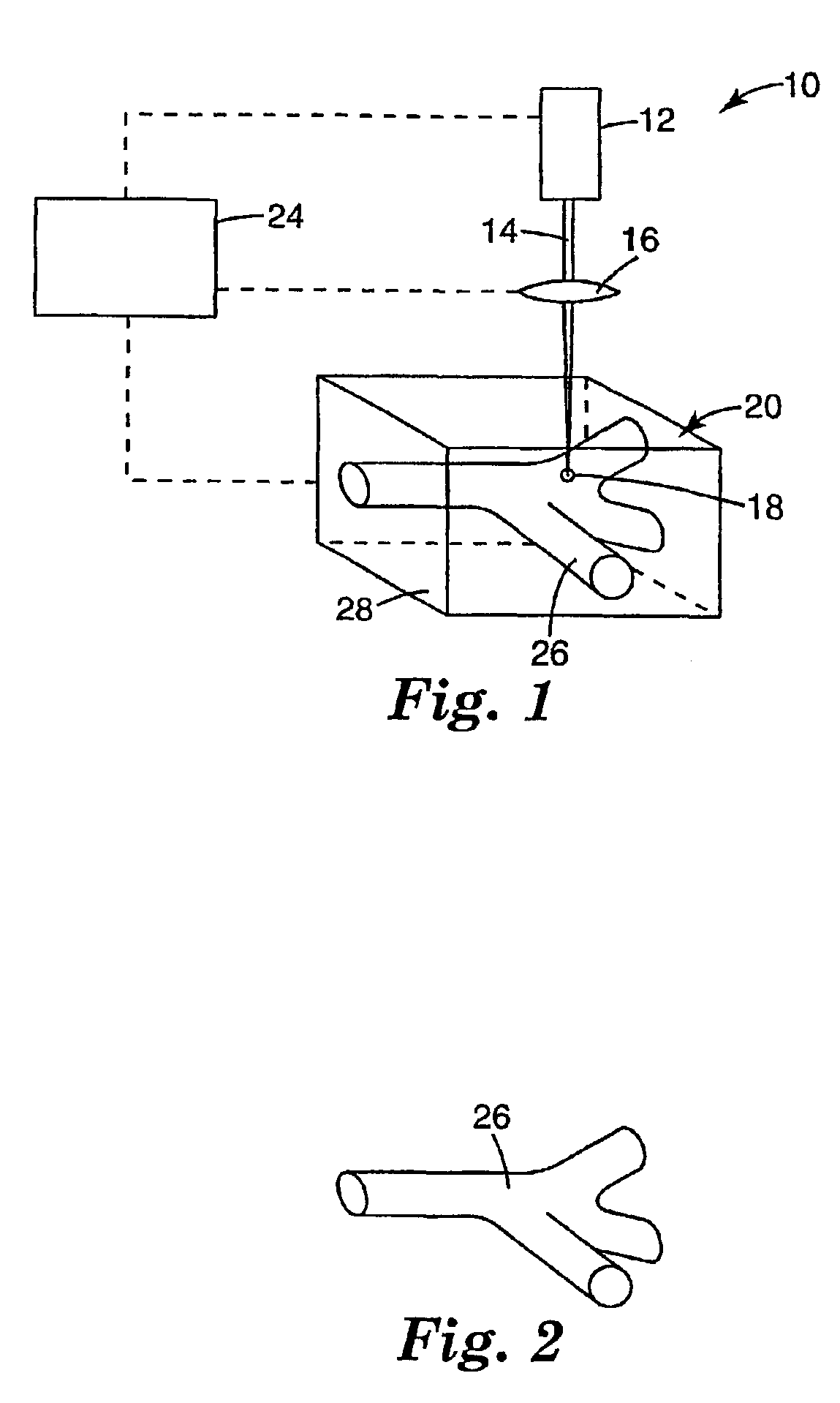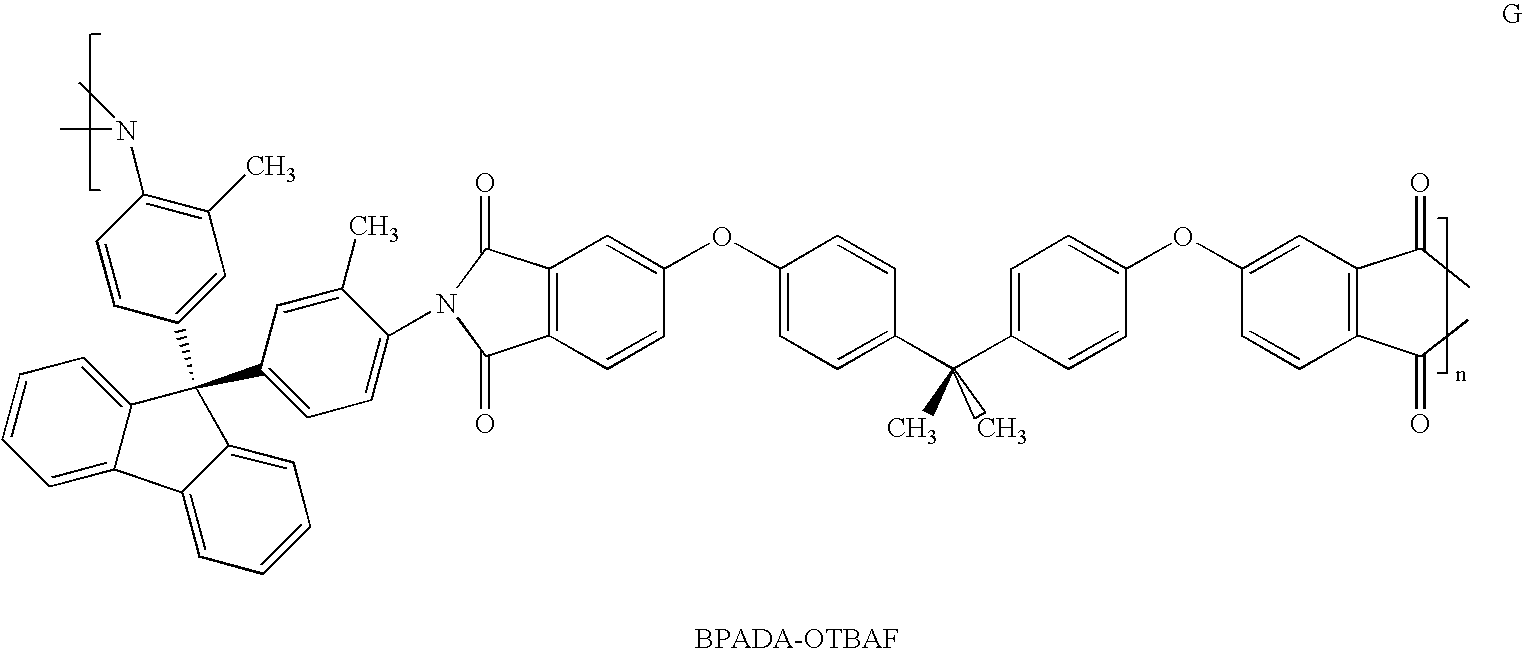Microfabrication of organic optical elements
- Summary
- Abstract
- Description
- Claims
- Application Information
AI Technical Summary
Benefits of technology
Problems solved by technology
Method used
Image
Examples
example 1
Example 1
A solution of photodefinable polyimide G
and two-photon photosensitization system including 4,4′-bis(diphenylamino)-trans-stilbene (1 weight %, based on solids) and diphenyliodonium hexafluorophosphate (1 weight % based on solids) is prepared in a suitable solvent (NMP) at approximately 20% solids and coated on a silicon wafer by knife coating to about 200-300 microns wet thickness. The coating is dried overnight (about 16 hrs) in an oven at about 50° C. Exposure and patterning is performed using a two-photon microscope with a Ti:Sapphire laser operating at the two-photon absorption maximum of 4,4′-bis(diphenylamino)-trans-stilbene, 700 nm, and the light is focused through a 40× objective with a focal length of 4.48 mm and a numerical aperture of 0.65. The pattern constituting the optical element is produced by manipulation of the substrate under the fixed focal point of the beam, accomplished by means of X-Y-Z servo-feedback-controlled translation stages equipped with high...
example 2
In this example, the following abbreviations are used:
MPS I—multiphoton photo sensitizer I prepared as described below.
DPI PF6—diphenyliodonium hexafluorophosphate, which can be made essentially as described in column 4 of U.S. Pat. No. 4,394,403 (Smith), using silver hexafluorophosphate.
Durimide 7520—a photoimageable polyimide, 40 weight % solids in NMP, available from Arch Chemicals, E. Providence, R.I.
NMP—1-methyl-2-pyrrolidinone, available from Aldrich, Milwaukee, Wis.
TMSPMA—3-(trimethylsilylpropyl) methacrylate, available from Aldrich, Milwaukee, Wis.
PGMEA—propylene glycol methyl ether acetate, available from Aldrich, Milwaukee, Wis.
(a) Reaction of 1,4-bis(bromomethyl)-2,5-dimethoxybenzene with triethyl phosphite:
1,4-Bis(bromomethyl)-2,5-dimethoxybenzene was prepared according to the literature procedure (Syper et al, Tetrahedron, 39, 781-792, 1983). The 1,4-bis(bromomethyl)-2,5-dimethoxybenzene (253 g, 0.78 mol) was placed into a 1000 mL round bottom flask. Triethyl phosphite ...
example 3
Preparation of Cylindrical Lenses:
An 85 micron film prepared as in Example 2 was mounted on a computer-controlled 3-axis stage, and the output of a Ti:Sapphire laser (part of a “Hurricane” system manufactured by Spectra-Physics Laser) (800 nm, 100 fs pulse, 29 mW, 80 MHz), equipped with a 40× objective lens (numeric aperature of 0.65), was focused into the film. The stage was programmed to move so as to produce a series of cylindrical lens images, each 100 micrometers wide by 200 micrometers long by 80 micrometers tall, with a radius of curvature of 100 micrometers. The sample was scanned under the focused beam at a rate of 1 mm / s to produce the structures. After development with cyclohexanone / 1-methyl-2-pyrrolidinone (4 / 1), a series of three-dimensional cylindrical lenses were obtained on a silicon wafer with the lens curvature normal to the silicon wafer substrate.
PUM
| Property | Measurement | Unit |
|---|---|---|
| Temperature | aaaaa | aaaaa |
| Temperature | aaaaa | aaaaa |
| Temperature | aaaaa | aaaaa |
Abstract
Description
Claims
Application Information
 Login to View More
Login to View More - R&D
- Intellectual Property
- Life Sciences
- Materials
- Tech Scout
- Unparalleled Data Quality
- Higher Quality Content
- 60% Fewer Hallucinations
Browse by: Latest US Patents, China's latest patents, Technical Efficacy Thesaurus, Application Domain, Technology Topic, Popular Technical Reports.
© 2025 PatSnap. All rights reserved.Legal|Privacy policy|Modern Slavery Act Transparency Statement|Sitemap|About US| Contact US: help@patsnap.com



